ABSTRACT:
The apparel manufacturing industry is constantly witnessing challenges and struggling to find the perfect balance between demand and production due to various reasons. Interdependence of the apparel manufacturers with the supply chain, logistics, labeling, tagging & packaging, raw-material vendors, and technologies, along with the economy and geopolitical instability, acts as a major factor for the run-up or the run-down of this industry. Constantly changing fashion is another major factor that is directly related to the growth of the apparel industry. Formal apparel is thinning down, while casual and fashion apparel is seeing a boom. Quick adaptation is the need of the hour.
Being a major contributor to the global economy, the apparel manufacturing industry employs a large workforce.
With a few twist factors like genderless fashion, direct-to-consumer business models, influencer marketing, local preferences, sustainability, and advanced technologies like AI, virtual reality, etc., the growth of the apparel industry is likely to boom in the coming years. A Digital Product Passport (DPP) is all set to clearly display a product's sustainability, environmental, and recyclability attributes. This is the latest move that can bring clarity to the apparel industry and the buyers, other than adding value.
GoodFirms’ survey titled ‘Apparel Manufacturing Industry: Trends and Setbacks’ attempts to take a closer look at this market and gain insights into the current trends in the apparel industry. The survey also tries to present details about the challenges faced by the industry.
Table of Contents:
Overview of the Apparel Manufacturing Industry
Apparel Manufacturing Survey Data Analysis by GoodFirms
Factors Driving the Growth of the Apparel Manufacturing Industry
Factors Influencing Buying Decisions
Current Trends in the Apparel Manufacturing Industry
- Customized Designs
- Sustainable Production Methods
- Personalized Touch and Unique Designs
- Handmade and Organic Products
- Genderless Fashion
- Localized Production
- 3D Printing
Challenges faced by the Apparel Manufacturing Industry
- Rapidly Changing Fashion Industry
- Supply Chain Issues
- Adaptability to Newer Technologies
- Adopting Sustainable Methods
- Labor Costs
- Regulatory Challenges
- Lack of Skilled Manpower
Practices Transforming the Apparel Manufacturing Industry
- Implementing AR/VR
- Automation of Possible Processes
- Real-time Data Analytics
- Traceability in the Supply Chain
- Integration of Machine Learning
- Implementation of ERP
- Reshoring and Nearshoring
Introduction
Apparel manufacturing is a dynamic industry with changing fashion trends, and customer buying behavior. Being an essential contributor to the global economy, the apparel manufacturing industry is undergoing a huge transformation with the assistance of modern technologies.
A number of challenges like the cost of labor, lack of skilled manpower, worker protection, supply chain, distribution, fluctuation in customer spending, transforming fashion trends, domestic manufacturing support, sustainability, compliance with the environmental act, import/export laws, illegal practices, etc., have certainly created obstacles to the growth of the apparel manufacturing industry. On the contrary, advancing technologies like automation, AI, machine learning, data analytics etc., agile marketing, D2C business, and multi-facility distribution channels are driving the growth of the industry.
The future of the apparel manufacturing industry has great potential for growth owing to the rising importance of the fashion industry.
GoodFirms’ research titled ‘Apparel Manufacturing Industry: Trends and Setbacks’, aims to explore the current trends in the apparel industry, management methods, challenges, and future growth of the industry.
Overview of the Apparel Manufacturing Industry
The apparel industry takes a major spot in global trade. Apparel manufacturing is the bulk production of the garments in the factories. It involves right from production planning, to costing, sampling, cutting, sewing, stitching, finishing, testing, packing, and supplying the orders domestically, nationally, and internationally. Precisely, it is a labor-intensive industry demanding the utmost efficiency in every process.
Market Size of the Apparel Manufacturing Industry
The global apparel manufacturing market accounts for USD 1.33 trillion and is estimated to grow at a CAGR of 4.63% between the years 2023 and 2028. The apparel industry is expected to reach a value of USD 1.67 trillion by the year 2028. (1)
The market has shown recovery from the pandemic crisis after the restrictions were lifted. The rise in Mcommerce, globalization, and disposable income in developing countries are some major factors that boost the growth of the industry. Increased efforts by marketing teams and the trend of influencer marketing have added to the number of millennials opting for frequent apparel purchases.
Globally, China, India, Japan, Bangladesh, and Vietnam are the largest contributors to the Apparel manufacturing industry.
The key players of the apparel manufacturing industry include Zara, Nike Inc., Under Armour Inc., Levi Strauss and Co., Mitsui, Adidas AG, VF Corp, Prada, and Kring SA.(2)
Apparel Manufacturing Survey Data Analysis by GoodFirms
GoodFirms’ survey titled “Apparel Manufacturing Industry: Trends and Setbacks,” conducted in August 2023, gives an idea about the factors influencing the apparel manufacturing industry and factors driving its growth. The survey also gathers insights into the trends and setbacks in the industry. The survey also aims to give an idea about the transformations of the industry and the responsible factors for the transformation.
The survey queried 470 businesses, which included sellers, retailers, suppliers, and consumers.
Factors Driving the Growth of the Apparel Manufacturing Industry
The apparel manufacturing industry has been consistently growing with the rising importance of fashion in the capacity of brands to manufacture apparel. There are several factors that drive the growth of the apparel manufacturing industry.

Globalization
Around 56.1% of the survey respondents said that globalization is a major driver of the apparel manufacturing industry.
Globalization has impacted the apparel manufacturing industry in a great way. The growth in global business has enabled brands to collaborate with suppliers from economic markets. The outsourcing of manufacturing processes to low-cost countries has been a rising trend due to the skilled labor available at lower costs.
Globalization enables large brands to outsource their processes and improve the probability of profit generation, which drives the growth of the industry.
Rise of Mcommerce
46.3% of surveyees believe that the rise in mCommerce drives the growth of the apparel manufacturing industry.
m-Commerce has largely helped a number of businesses due to the rising number of smartphone users, and the availability of high-speed internet. With the availability of digital platforms, the fashion industry has shown tremendous growth.
The pandemic period, specifically, has fueled the growth of mobile commerce. The convenience of shopping from anywhere, along with the facility to pay via multiple payment methods, has fueled the growth of M-commerce. This has hugely impacted the apparel manufacturing industry.
Consumer Demand
Consumer demand is a major driving factor for the growth of the apparel industry, said 45.5% of the survey participants.
Recent years have witnessed higher demand for apparel products. The rise in the millennial and Gen Z population and the inclination of consumers toward new fashion trends like unisex apparel has increased the demand for apparel products.
The introduction of trends like livestream ecommerce via social media platforms and celebrity influencers is also driving the consumption of apparel products, leading to the rise of consumer demand.(3)
Economic Conditions of the Consumer
Improved economic conditions of the consumers lead to the growth of the apparel industry, according to 36.2% of the surveyees.
There has been a significant rise in the disposable income of consumers in developing countries in recent years. With the rise in disposable income, consumers are keen on improving their lifestyle, which leads to an inflated demand for garments.
It is predicted that disposable income is set to rise further in the coming years.(4) Owing to more ability to splurge on improving the lifestyle, the demand for garments and apparel products is on the rise.
Factors Influencing Buying Decisions
The growth of the apparel manufacturing industry is highly dependent on the buying decisions of consumers. However, the buying decision of consumers relies on several factors. GoodFirms’ survey unveils the factors that influence consumer buying decisions.
“In my opinion, the design, fabric, and cost are the best features that help a consumer to buy a product,” mentioned Tushar Mehta, CEO of Mobikasa.
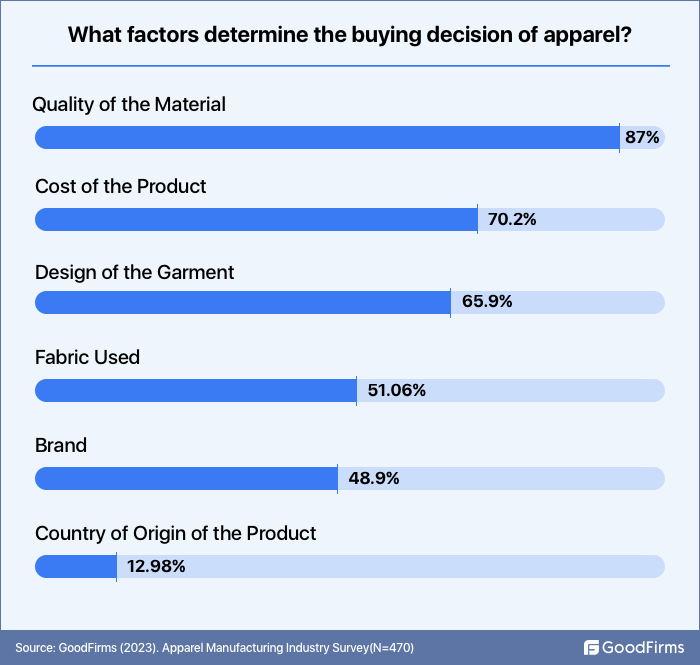
Quality of the Material
87% of the survey participants believe that the quality of the material is an influential factor in making a purchase decision.
The quality of the material in an apparel product is a major factor for consumers to make their buying decisions. Quality ensures a defect-less product with the required comfort and desired look.
According to a consumer survey, 76% of consumers pay attention to the quality of the garments and footwear they are buying.(5)
The quality of the apparel is determined by the size and fit of the garment, the comfort offered by the product, and the durability of the product. The stitching of the apparel and the quality of accessories used to finish the garments make the end product of good quality.
Cost of the Product
Nearly 70.2% of the survey respondents said that the cost of the product influences the consumer buying decision.
One of the major factors that have influential importance on consumer buying decisions is the cost of the product. The cost of an apparel product is determined by the design, quality, cost of production, and brand.
With budget constraints and the need to buy apparel, there arises a frequent demand for low-cost options, especially for millennials and Gen Z, who care less about the brand and focus more on budget-friendly fashion.
Design of the Garment
The design of the garment influences the buying decision for 65.9% of surveyed consumers.
The design of the garment plays a crucial role in influencing the buying decisions of consumers. Consumers feel confident when they wear something aesthetically pleasing.
Knowing the customers and introducing them to the latest designs may lead to an increase in sales for them. The design of a garment creates an impression on the buyer to make the buying decision.
The ever-evolving fashion industry results in a change of fashion every few days, demanding change in designs. A personalized touch and unique design can help in attracting customers.
Fabric Used
Nearly 51.06% of the survey participants said the fabric used in the garment influences their buying decisions.
The most important raw material for the apparel manufacturing industry is fabric. With a range of natural and synthetic fibers available, there are several types of fabrics that are being used in the apparel manufacturing industry.
The chemical and physical quality of every fabric determines the look and feel of the garment. The type of fabric used, therefore, makes a difference for the consumers to make their buying decisions. The comfort and durability of the fabric are essential factors to consider when buying apparel products. Also, allergy to a particular fabric type for some consumers also results in influencing the buying decision.
Brand
The brand of the product influences the buying decision for 48.9% of the survey participants.
The quality of a product is often associated with the brand of the product. Also, the younger generation has a sense of pride in owning apparel from top brands.
Moreover, the brand of a product is responsible for creating trust among the consumers. A better brand assures fabric quality, stitch, and thread quality to make the product more durable. Brands usually offer the current trends with better quality and value for money. With better comfort and added elegance, branded products have an impact on consumer buying preferences.
Country of Origin
Nearly 12.98% of the surveyees asserted that country of origin is an influential factor in consumer buying decisions.
The country of origin of an apparel product has a considerable impact on the consumer buying decision. With many countries having made a name for themselves in particular niches, consumers check the country of origin tag before buying the garments.
The country of origin of the product also impacts the price of the product, which has a huge influence on the consumer buying decision. The association of some countries with the quality of goods produced also impacts apparel purchase decisions to some extent.
Current Trends in the Apparel Manufacturing Industry
The apparel industry is closely related to the fashion industry. The industry is directly impacted by consumer behavior and consumer attitudes towards the trends in the industry. It is a dynamic and ever-changing industry that witnesses transformation with the changing trends.
GoodFirms’ survey, ‘Apparel Manufacturing Industry: Trends and Setbacks’, gains insights into the current trends of the apparel industry that will shape the future of the industry.

Customized Designs
Around 78.4% of the survey respondents believe that customized designs are a leading trend in the apparel industry.
Custom clothing is a huge boost to the apparel industry, which has led to the emergence of several trends. The rise of customized designs is a result of increased penetration of the internet, smartphones, and the availability of advanced printing technologies that facilitate customized designs.
Understanding consumer demands and introducing designs that suit their requirements is a great way to build consumer confidence. Custom printed clothing like t-shirts and caps are widely used as branding tools, commonly seen in many industries.
The custom apparel industry is forecasted to grow at a CAGR of 7.22% between the years 2022 and 2027. (6)

Obtaining feedback from customers and working on customizations is a great way to meet consumer requirements.
Sustainable Production Methods
For 74.4% of the survey participants, sustainable production methods are a current trend in the apparel industry.
One of the most popular trends evident in the apparel manufacturing industry is adopting sustainable production methods. Adoption of sustainable production methods helps in reducing the carbon footprint, energy consumption, and health risks for workers.
The use of natural fabrics, proper recycling methods, and conservation of energy can be a few steps that businesses can take to adopt sustainable production practices.
Adoption of water-conserving methods, use of renewable electricity sources, reduction of packaging waste, and use of proper waste management are all practices that can be a move towards improving sustainability.
Personalized Touch and Unique Designs
Personalized touch and unique design emerge to be a crucial trend in the apparel industry, according to 63.8% of the survey participants.
One of the most common issues that the apparel industry faces is stiff competition, as there are a number of brands always trying to attract customers. Trends like fast fashion make the competition even more intense.
To overcome this challenge and stand out from the crowd, brands have to offer unique designs for the customers to choose from. The trend of having a personal touch in the garments produced can help brands get noticed in the competition.
Handmade and Organic Products
Handmade and Organic Products are a major trend in the apparel industry, asserted 55.3% of surveyees.
Handmade and organic products are gaining tremendous popularity as they can have low environmental impact. With the growing awareness of environment-friendly products, handmade and organic products are becoming a favorite among consumers.
Handmade products, being made by skilled artisans, are superior in quality and made to precision. Organic products are also made with natural raw materials that are good for the consumers. Organic and handmade apparel is made to perfectly fit the consumer and can be easily altered.
Genderless Fashion
31.9% of surveyed businesses believe that genderless fashion is a major trend in the apparel industry.
Genderless fashion is a concept that creates fashion products that are gender-neutral. According to a survey by Statista, nearly 85% of Gen Z responders thought of buying gender-neutral fashion products.(7)
"As contemporary society becomes more open and accepting of different gender identities and expressions, the apparel industry has moved in parallel to accommodate these shifts. Genderless fashion is the latest move in the apparel industry with fashion players shifting towards a more inclusive understanding of gender and creating genderless clothing lines.," says Dharmendra Ahuja, the Founder and CEO of VasyERP.
With many fashion giants introducing a range of genderless products, this trend is to look out for. The growing importance of concepts like prioritizing individuality and the freedom to choose colors and styles irrespective of gender are leading to the growth in the acceptance of gender-neutral fashion lines.
Localized Production
Prioritizing localized products is a current trend in the apparel industry, according to 29.7% of the survey participants.
The initiatives by governments to support local production are a reason for brands to focus on localized production. Also, the production of apparel products by local workers ensures cultural and social understanding of the garment design. Collaborating with local suppliers and workers results in an efficient supply chain.
The pandemic era made the apparel industry see the vulnerabilities of the global supply chain, which gave rise to concepts like nearshoring and reshoring.
Nearshoring is the practice of relocating the manufacturing unit closer to the target market, whereas reshoring is about relocating the production plants back to the home regions. Both concepts are focused on shortening the supply chain to reduce the time to market, supporting local talent, and reducing the supply chain costs.
3D Printing
For 21.6% of surveyees, 3D is one of the major current trends in the apparel manufacturing industry.
3D printing in the apparel industry is a growing trend and has numerous applications in the industry. From building prototypes to designing an entire collection, businesses can utilize 3D printing in a number of ways.
3D printing, when used for designing a product, businesses can assess any defects and fix it in real time. 3D fashion technology is a great way to achieve sustainability in the production process. The technology is also a great aid for introducing customizations as per client requirements.
With proper expertise and creativity, 3D printing technology can be used to create unique and complex apparel products.
Challenges faced by the Apparel Manufacturing Industry
The demand for garments has consistently been increasing with the rise in modernization and population. Although the industry is growing, it has a number of challenges that are obstacles to the smooth functioning of the industry. Opting for proper measures and precautions can help in minimizing the challenges faced by the industry.
The Apparel Manufacturing Survey by GoodFirms sheds light on the challenges faced by the apparel industry.
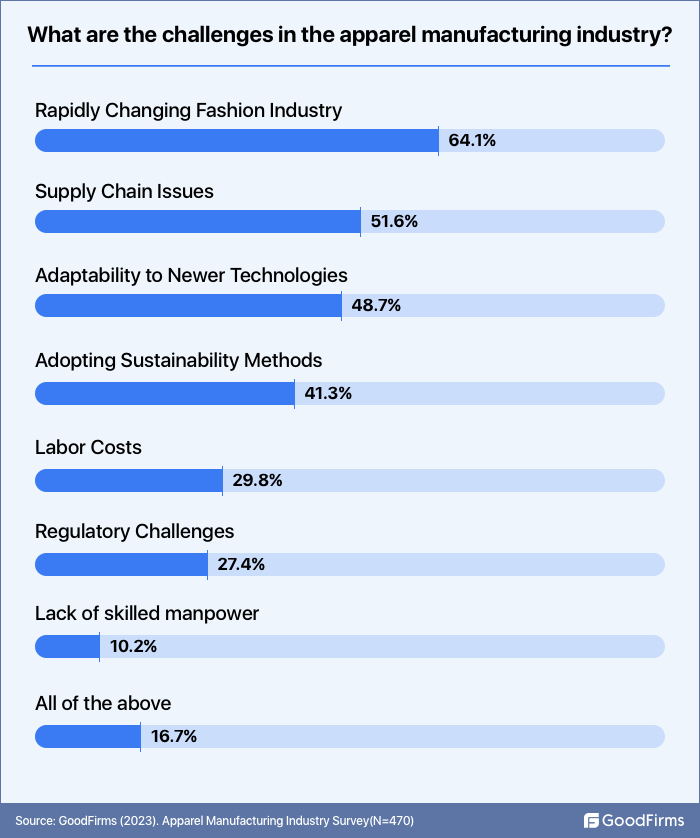
Rapidly Changing Fashion Industry
About 64.1% of surveyed businesses said that the rapidly changing fashion industry is challenging for the apparel industry.
The fashion industry is evolving every day. Consumers demand newer fashion, which makes it challenging for apparel manufacturers to keep up with the demand, and bring newly produced products at a higher pace.
Concepts like fast fashion that enable the introduction of new fashion lines at cheaper rates and faster paces have adverse effects on the planet and the workers. The mass production of clothing at higher speeds may involve the exploitation of workers and the generation of unnecessary wastage from the industry.
Coping with the rapidly changing fashion industry and meeting consumer demand is challenging for apparel manufacturers while adopting sustainable methods of production.
Supply Chain Issues
51.6% of businesses considered supply chain issues as a crucial challenge for apparel manufacturers.
One of the major challenges that the apparel manufacturing industry faces is supply chain disruptions. Material shortages, uncertainty of worker turnover, transportation deadlines, and rising shipping costs all add up to increasing supply chain issues.
With only a limited number of suppliers, the dependency on them is inflated, leading to delayed turnaround times. Introducing automated workflows with advanced technologies like supply chain software and inventory management tools becomes crucial to avoid inventory shortages.
Defective products and numerous returns add to the challenges with the supply chain that the apparel industry already has to deal with.
The introduction of IoT is a great initiative towards introducing transparency in the supply chain.

Nearly 52.8% of participants of the GoodFirms survey believed that the introduction of IoT can help improve supply chain transparency.
Adaptability to Newer Technologies
Adapting newer technologies poses a critical challenge in the apparel manufacturing industry, 48.7% of the survey respondents favored this.
Unlike other industries, the apparel manufacturing industry is a bit slow in adopting new technologies for automating processes. Knowing the value addition of the tool or service is the only solution to this challenge.
Although automation can help reduce the turnaround time and solve supply chain issues, most automation technologies chosen without proper assessment can pose risks for fabric handling. Sewing the clothes at high speed may result in increasing the needle temperature, which leads to defects in the final product. Fabric types that are delicate or more flexible are difficult to be handled by machines.(8)
Moreover, training the available human resources to use the newer technologies is a huge task for brands to make optimum use of the technology. A lack of technical training or knowledge to embrace automation technologies leads to slower adoption of automation.
Adopting Sustainable Methods
41.3% of the survey participants considered adopting sustainable methods as a major challenge in the apparel manufacturing industry.
The rising demand for sustainability and the awareness among consumers about sustainable methods make it a compulsion for brands to implement sustainable production methods.
It is estimated that the carbon emissions from the fashion industry will account for 2.7 billion metric tons by the year 2030 if no measures are taken. (9) The numbers are quite significant, and strict measures for abatement need to be taken to reduce the carbon footprint of the industry.
The textile industries use several chemicals in the process of dying and processing to improve the apparel quality. 17 to 20% of industrial water pollution is generated by the textile industry. Out of the 72 chemicals identified in the water used entirely for dyeing, 30 cannot be removed.(10)
It is necessary for brands to consider options to eliminate or reduce the use of chemicals.
The adoption of sustainable production methods like energy and water conservation, waste recycling, and renewable energy sources are some steps to be taken by the industry. With the rising awareness of sustainability among consumers, adopting these methods is also a great way to have a competitive edge in the industry.
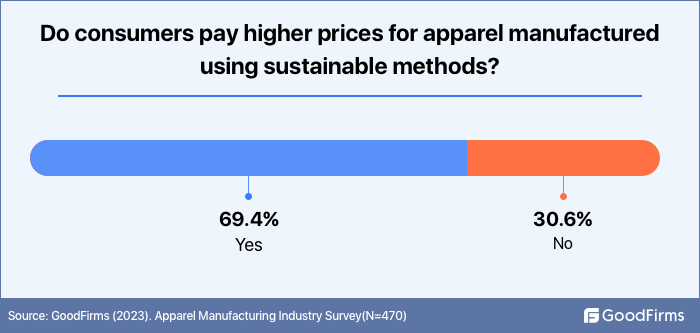
Labor Costs
Rising labor cost is a crucial challenge for 29.8% of surveyed businesses.
The apparel industry faces a shortage of talented human resources. The manufacturers are, therefore, forced to hire workers by offering them higher costs.
“The garment industry is under pressure from multiple fronts. Inflation and economic uncertainty are not only affecting customers’ confidence and purchasing power but impacting manufacturers and retailers who are absorbing the rise in wages, rise in the cost of raw materials, and factors associated with their supply chain — logistics, fuel, and energy costs,” points out Ray Fernandez, Content Communication Specialist at BizReport.
Manpower is an essential aspect of the apparel industry since it is labor-intensive. With the worldwide rise in labor costs, countries like India and China face this challenge to a greater extent as they are the hubs for apparel production. With the rising inflation, apparel manufacturers are challenged by higher operational costs that impact their margins. Dealing with rising inflation can be made possible only by implementing strict measures to improve productivity and supply chain efficiency in the apparel industry.
Regulatory Challenges
Complying with laws and regulations is challenging for apparel businesses, according to 27.4% of survey respondents.
The apparel manufacturing industry is scattered across the globe. Most of the processes for a business are carried out in different countries.
The global nature of the industry helps businesses to cut down on costs associated with human resources and other basic requirements. However, laws and regulations vary with every country, which poses a significant challenge for businesses.
Operating in different countries requires brands to comply with varied regulations regarding labor safety, environmental protection, and taxes on the business. Complying with a range of standards and regulatory boards is a challenging task for the smooth functioning of the business.
Lack of Skilled Manpower
Lack of skilled manpower is a challenge in the apparel manufacturing industry, according to 10.2% of respondents.
The apparel industry largely depends on skilled manpower to produce good-quality products. Right from creating unique designs to handling sensitive fabric types, human intervention is an important aspect of the apparel industry.
Cutting and finishing fabric to transform it into a wearable garment requires manual attention for best results. However, the industry faces a lack in the number of available human resources to meet the supply chain demands.
Estimates reveal that the textile industry witnesses around 20% of labor shortages.(11)
Brands are expected to make extra efforts to train unskilled workers to be ready for high-demand seasons.
Practices Transforming the Apparel Manufacturing Industry
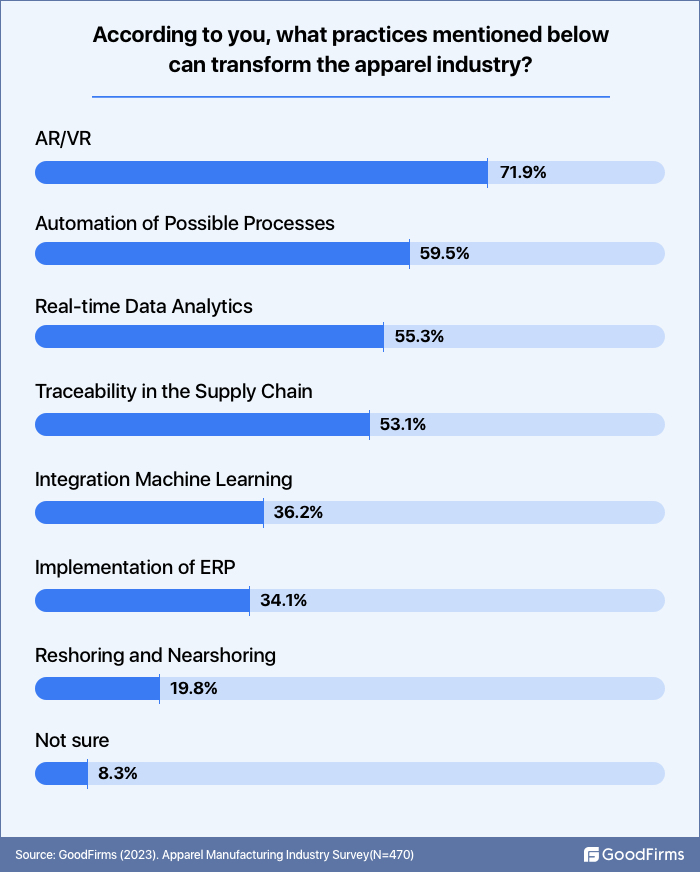
Implementing AR/VR
An important practice in transforming the apparel manufacturing industry is implementing AR/VR, said 71.9% of survey respondents.
The introduction of AR and VR in the apparel industry can improve the shopping experience for consumers. Brands can utilize these technologies to give them an immersive experience, improving engagement rates.
Brands like GAP, Gucci, and Walmart have embraced these technologies to provide their customers with virtual try-on experiences to assure them of their purchases. (12)(13)(14)
With immersive and engaging shopping experiences, brands can leverage benefits like increased customer engagement, improved customer satisfaction, reduced cost on returns, and enhanced sales.
Automation of Possible Processes
Automation of processes by apparel manufacturers can transform the industry, asserted 59.5% of the surveyees.
With the rising burden on the apparel industry and rising labor costs, automation is being adopted in the industry. Automating tedious manufacturing processes can help improve productivity and efficiency, and help in reducing the time to market.
The integration of automation in the apparel industry can help improve processes like planning, cutting, sewing, and assembly. Software solutions are available for automating and controlling the processes.
Jaza Software mentioned, “Automation is revolutionizing the apparel manufacturing industry, increasing efficiency and reducing costs.”
Implementing apparel management software can help businesses to have complete control of the production processes and streamline them.
Real-time Data Analytics
According to 55.3% of survey participants, real-time data analytics can transform the apparel manufacturing industry.
The COVID-19 crisis proved to be a major setback for the apparel industry like any other industry. With reduced sales and rising inflation effects, the apparel and fashion industry faced a lack of consumer confidence.
Data analytics came out to be a great help for gathering insights about the trends in the industry and assisting businesses in having a roadmap for the future.
Apparel businesses have opportunities to collect data from various sources to help in sales and trend forecasting and planning the production processes. Real-time data collection and analysis offers benefits like consumer demands, consumer choices, sales forecasting, improved inventory management, personalization, and data-driven decisions.
Traceability in the Supply Chain
Supply chain traceability is a transforming practice for the apparel industry, asserted 53.1% of the surveyees.
Supply chain disruption is the most widely faced hurdle in the growth of the apparel manufacturing industry. Introducing traceability and transparency in the supply chain is a crucial step to reduce the losses associated with supply chain issues.
Traceability in the apparel industry gives businesses clear visibility through all the stages of apparel production, from the sourcing of raw materials to the delivery of the finished product to the consumers.
Traceability can be achieved by the use of technologies like Radio Frequency Identification tagging, blockchain technology, IoT-enabled sensors, or proper supply chain management systems that track the movement of products. Proper traceability and transparency in the apparel manufacturing industry is a step to improve the efforts for ethical production, enhance customer confidence, and have a sense of accountability at every stage.
Integration of Machine Learning
Nearly 36.2% of businesses consider the integration of machine learning as a transformational approach for the apparel manufacturing industry.
Integration of machine learning and artificial intelligence can greatly help the apparel industry to transform the ways it works. From personalized designs to accurate forecasting, machine learning can be a solution for improving the efficiency of the industry. Interestingly, a survey reveals that 96% of the participants planned to invest in AI implementation in the near future.(15)
Artificial intelligence and machine learning can help businesses in precise forecasting of sales in the future. Also, machine learning can assist in optimizing the supply chain by analyzing the products that are in demand and the ones that need not be produced based on consumer demand.
These technologies can also be adapted for automating quality control processes, leading to efficiency and cost reduction.
Implementation of ERP
According to 34.1% of the surveyed businesses, ERP implementation can help in transforming the apparel manufacturing industry.
ERP software solutions have proven their need in all industries, and the apparel manufacturing industry is no exception. The apparel industry has a number of processes performed by various departments.

Implementing a sophisticated ERP system can help businesses keep all the concerned departments on a single page, thereby improving transparency and streamlining processes. The availability of real-time data helps in proper planning and forecasting to have proper control over the supply chain and manufacturing of the products.
Reshoring and Nearshoring
Practices like reshoring and nearshoring can transform the apparel manufacturing industry, said 19.8% of the survey participants.
The COVID-19 pandemic period made businesses witness the uncertainties associated with globalization in every sector. The worldwide lockdowns resulted in the termination of processes that were dependent on the outsourcing of goods and services. Many businesses in the apparel industry have opted for reshoring and near-shoring strategies to bring the business process geographically closer.
Adopting the reshoring strategy results in bringing most of the supply chain linkages in the same time zone, providing businesses with more control over the manufacturing processes. Reduced complexity of the supply chain results in lowered risks of shipping hazards.
Nearshoring involves outsourcing the processes to nearby countries to the client's location, resulting in a shorter time to market and improved control over the supply chain.
Future of the Apparel Manufacturing Industry
The apparel industry has been seeing consistent growth, occupying a majority of the global trade ecosystem.
It is evident that the industry is transforming at a great pace due to the implementation of transformational technologies. Also, measures to tackle the challenges are effectively being implemented by brands.
The transformation of the apparel manufacturing industry is necessary as the industry is a major contributor to the global economy.
Fashion for Social Cause
The apparel industry is greatly influenced by the trends in the fashion industry. Recently, the apparel industry has seen many changes that can be considered as initiatives for some social causes. The inclusion of plus-size apparel and the freedom to choose clothing that is gender-neutral can help in overcoming issues like body-shaming.
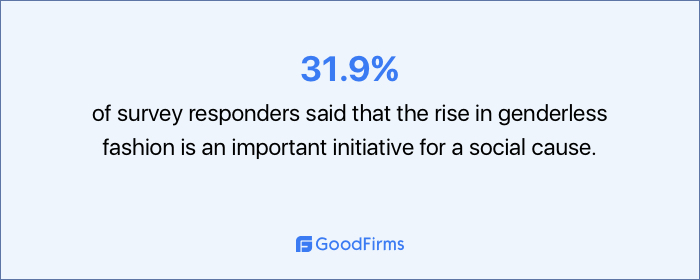
Changing Marketing Modes
Owing to the rising internet and smartphone penetration, the modes of marketing are evolving in almost all industries. The apparel manufacturing industry is also leveraging marketing modes like social media marketing and influencer marketing.
Millennials and Gen Z consumers, especially, have a tendency to make purchasing decisions inspired by their favorite celebrities or social media influencers.
GoodFirms’ survey reveals that 49.1% of businesses believe that social commerce or Live streaming ecommerce via social media is a reason behind the growth of the apparel manufacturing industry. There are more customers opting for Livestream shopping.(16)
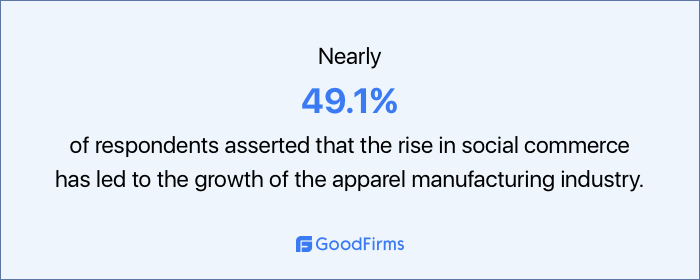
Rise in Handmade Fashion
Although the processes in the apparel industry are being automated with the help of technology, the popularity of handmade products has never faded.
The authenticity and designs of handmade products are unmatchable and give a great look and feel experience. Moreover, handmade fashion is an excellent means of providing employment to skilled artisans.

There is a trend of supporting handmade products to nurture the local culture and help improve the rate of employment. The trend of handmade products is expected to stay in the future as well.

Enhanced Sustainability
Improving sustainability is the need of the hour for every industry. The growing awareness about the importance of enhanced sustainability and reduced wastage is the factor responsible for industries to adopt sustainable methods.

The strict laws and regulations implemented by governments to preserve the environment and reduce carbon footprints are responsible for gaining higher importance across the world. The apparel industry has an adverse impact on the environment. Trends like fast fashion add to the adversities of the environment. The future will, therefore, see more transparency and accountability in the processes, and a gain in the importance of sustainability and reduced wastage. Generative AI will have a huge hand in helping the industry work as per the customers’ requirements, and in practicing sustainability.
Key Findings
-
The apparel manufacturing industry is a versatile and dynamic industry that is a major contributor to the global economy.
-
The apparel manufacturing industry is expected to grow at a CAGR of 4.63% between the years 2023 and 2028.
-
Around 56.1% of the survey participants believe globalization to be a major factor driving the growth of the apparel industry.
-
The increasing internet and smartphone penetration contributes to the growing apparel industry.
-
Quality of the material is a factor influencing the consumer buying decision, according to 87% of survey respondents.
-
The cost of the product and the design of the garment are among the top parameters considered by consumers to make a buying decision.
-
Nearly 78.4% of respondents said that customized design is the latest trend in the apparel manufacturing industry.
-
74.4% of surveyees asserted sustainable production methods to be the latest trend in the apparel industry.
-
The apparel industry faces challenges like the rapidly changing fashion industry and supply chain disruptions.
-
The difficulties in adopting new technologies make it difficult to automate processes for apparel manufacturing.
-
Implementation of technologies like AR/VR and machine learning can enhance the growth rate of the apparel industry.
-
IoT can help the apparel manufacturing industry to improve transparency and traceability in the supply chain.
-
To have better control over production processes and supply chains, many businesses are adopting strategies like reshoring and nearshoring.
-
The future of the apparel industry will see a rise in social commerce and the inclusion of influencer marketing.
-
The apparel manufacturing industry is set to adopt newer fashion trends like gender-neutral fashion in the coming years.
Conclusion
The rise in the use of ecommerce and rapidly changing fashion trends have boosted apparel sales while burdening the brands with shorter lead times and coping with the rapid changes. One of the major trends that the brands need to follow is adopting sustainable manufacturing methods. With the rising importance of social and environmental sustainability, business owners are responsible for ensuring environmental and worker safety.
Adoption of newer technologies to automate tedious and mundane processes and streamline processes with the help of software solutions can be a significant step towards functioning efficiently.
We sincerely thank our Research Partners for their valuable insights.
References
-
https://www.mordorintelligence.com/industry-reports/apparel-market
-
https://www.thebusinessresearchcompany.com/report/apparel-global-market-report
-
https://www.goodfirms.co/resources/livestream-ecommerce-market-future-scope
-
https://www.euromonitor.com/article/the-rise-of-a-higher-income-middle-class-in-emerging-markets
-
https://www.powerreviews.com/research/apparel-footwear-shopping-survey-2022/
-
https://www.technavio.com/report/custom-apparel-market-industry-analysis
-
https://www.statista.com/statistics/1331311/gender-neutral-fashion-shopping-intention-us-generations/
-
https://textilelearner.net/challenges-of-automation-in-garment-industry/
-
https://www.mckinsey.com/industries/retail/our-insights/fashion-on-climate
-
https://www.forbes.com/sites/brookerobertsislam/2019/10/25/this-company-wants-chemical-ingredients-listed-on-our-clothes-labelsheres-why/?sh=3affb2e991a0
-
https://www.oracle.com/retail/fashion/fashion-retail-challenges/
-
https://venturebeat.com/ai/guccis-ios-app-lets-you-try-shoes-on-remotely-in-ar/
-
https://techcrunch.com/2022/09/14/walmart-introduces-virtual-try-on-tech-which-uses-customers-own-photos-to-model-the-clothing/
-
https://www.textiletoday.com.bd/augmented-reality-ar-virtual-reality-vr-fashion-industry/
-
https://risnews.com/retail-2021-ai-ushers-new-decade
-
https://www.goodfirms.co/resources/livestream-ecommerce-market-future-scope




